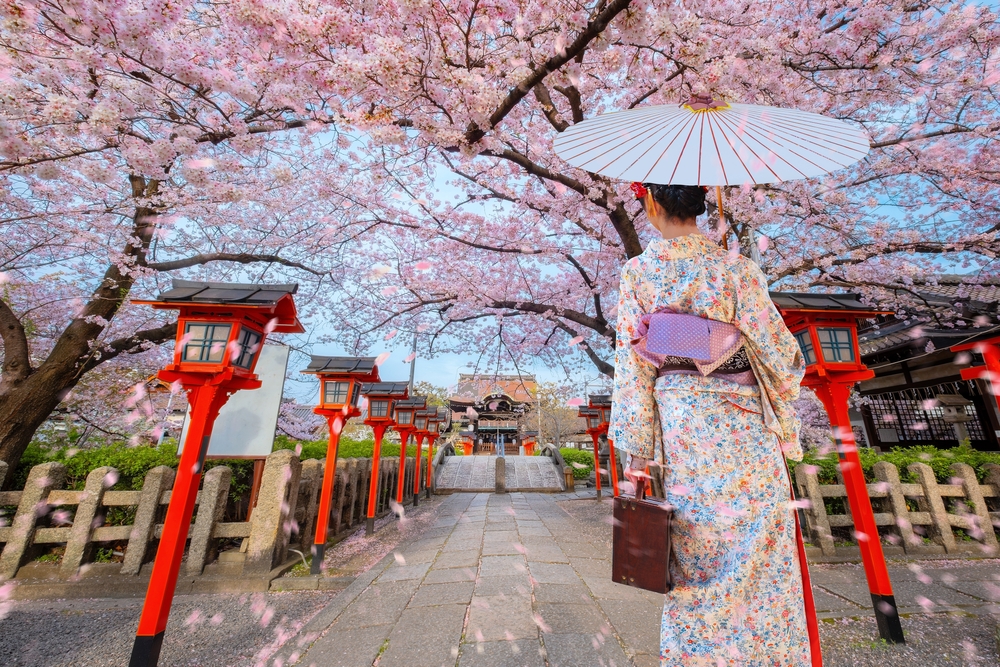Have you ever wanted to experience Japan’s cherry blossom season? We spotlight several top spots in Kyoto that will make this dream come true.
Every year, between late March and early April, Japan’s iconic cherry blossoms (sakura) come into full bloom. This special time of year is called hanami, which translates to “flower viewing.” Hanami is a beloved national pastime in Japan, and there’s no better place to enjoy it than in Kyoto. This ancient capital is home to thousands of cherry trees, and each spring, tourists from all over the world flock to the city to admire their beauty.
1. Daikakuji Temple
The ancient Daikakuji Temple was built in the 800s and is one of the most popular Shingon Buddhist temples in Japan. Located in the scenic region of Arashiyama, you can see cherry blossoms around the temple pond. This beautiful temple has been used as a filming site for many historic dramas, so make sure you leave enough time to stroll the courtyards. Another hanami spot is the iconic Togetsukyo Bridge, which is just nearby.
The admission fee is 500yen for temple (approx SGD$5) and 300yen for garden around Osawa pond (approx SGD$3). The site is open daily from 9am to 5pm (last entry at 430pm).
Grab the Japan Rail Pass, an efficient and economical way of getting around Japan!
2. Maruyama Park (near Yasaka Shrine)
View this post on Instagram
Okay, so the cherry blossoms are not directly at the shrine, but at the park next to it. The Maruyama Park is a must-visit as it is the most popular local park for hanami celebrations! During the sakura season, food stalls are set up in the park, and the large sakura tree is illuminated at night.
3. Philosopher’s Path (at Ginkakuji Temple)
Ginkakuji is a zen temple in the mountainous Higashiyama region. It was modeled after Kinkakuji, also known as the Gold Pavilion. You can find the sakura at the Philosopher’s Path, which is next to the canal beside the temple. Walking through the path during golden hour is a truly enchanting experience, there are hundreds of cherry trees lining the street!
Admission is 500 yen (approx. SGD$5) and the grounds are open from 9 am to 430pm (December to February) and 8am to 5pm (March to November).
4. Heian Shrine
The Heian Shrine is a beautiful Shinto temple that was built to mark the 1100th anniversary of Kyoto’s founding. The grounds are landscaped with hundreds of cherry trees and house many interesting features for visitors, including an exhibit on Japanese history that visitors can explore. One feature stands out as being particularly stunning: these Weeping Cherry Trees, which bloom later than most other types throughout late April or early May, making this garden one of the best cherry blossom spots in Kyoto around the tail end of the season.
No entrance fee is required to enter the shrine grounds. However, if you wish to visit the Heian Shrine Garden, you will need to pay an admission fee of 600 yen (approx. SGD$6). The shrine is open daily from 6am to 5pm.
Bonus!
Okazaki Canal, outside Heian Shrine![]()
There are many weeping sakura trees lining this canal too. During spring, there are boat tours to appreciate the pink surroundings.
5. Daigoji Temple
A UNESCO world heritage site, the Daigoji Temple is a Shingon Buddhism temple famous for its architecture and scenery.
Located at the foot of a mountain, there are many hiking trails for nature enthusiasts. The cherry blossoms can be found at the Reihokan Museum and in front of the Sanboin. Admission is 1500 yen (Approx SGD$15) which grants you access to Sanboin, Shimo Daigo and Reihokan Garden. The temple is open from 9am to 5pm.
6. Kiyomizudera
Another UNESCO world heritage site, the Kiyomizudera is named after the beautiful waterfalls in the region. The most iconic feature of the site is the wooden stage, from which visitors can enjoy a stunning view of the blooming sakura. There are cherry blossoms on the temple balcony, but there are more cherry trees near the garden at the exit. Kiyomizu-Dera’s trees reach a peak in early April. Admission is 400 yen (approx. SGD$4) and the grounds are open from 6am to 6pm.
7. Ninnaji
The Ninnaji Temple is the head temple of Shingon Buddhism, and was once even known as the Omuro Imperial Palace. Although founded in 888, none of the original buildings have withstood the test of time. Currently, the oldest structures left are from the Edo Period in the 1600s. The sakura trees are scattered across the temple grounds, and they are the Omuro Cherries. This variety is best known for blooming later than the typical Yoshino ones. Admission is 500 yen (approx. SGD$5) and the grounds are open from 8am to 530pm (no entry after 5pm).
8. Hirano Shrine
The Hirano Shrine is one of the top hanami spots in Kyoto, and has had annual cherry blossom festivals since year 985! Food stalls and tables are arranged under the trees for one month, to the pleasure of visitors who come in numbers for Ohanami. The festival is more than just a gathering under the pink trees. Instead, there will be a morning ceremony at the mausoleum of Emperor Kazan, followed by a procession around the shrine.
Admission to Hirano Shrine is free.





